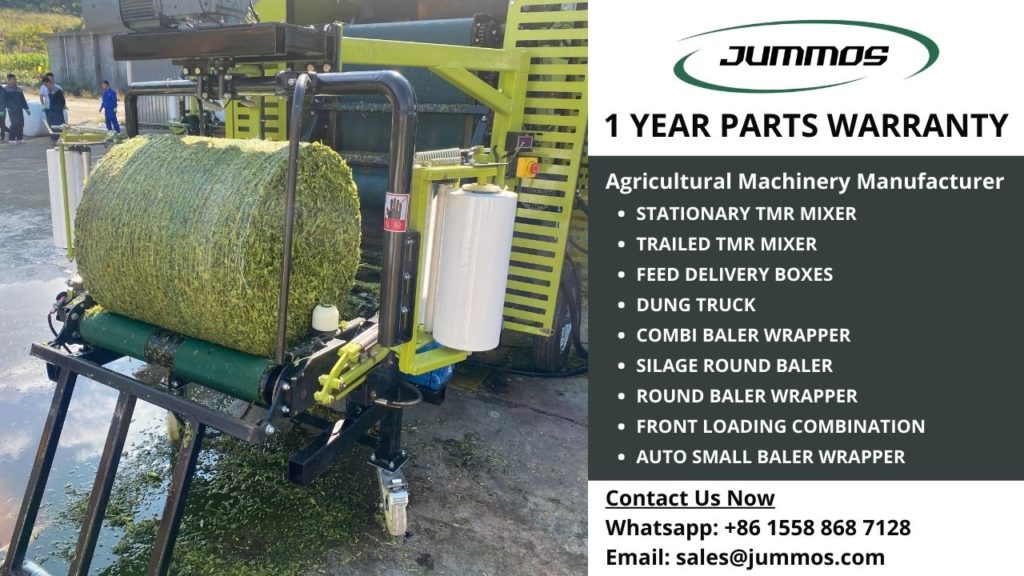
The high price of animal feed makes farmers have to start seriously in making silage and independently managing feed production. The use of round bale wrappers should also be considered to streamline the process of storing animal feed sustainably. Especially if you are a medium and large-class livestock farming business, feed management must be accompanied by technology that can make the work process more effective and efficient.
Contents
What Are Round Bale Wrappers?
This is an automatic bale wrapping tool with special plastic making it easier for farmers and ranchers to make silage. After the harvest takes place, straw, various grasses, and other crops are made into bales, either in the form of rolls or in the form of boxes.
Making bales can be done manually or using a special machine for a neater and denser final result. The bales are then immediately wrapped in a special tool so that the fermentation process goes well until the bales are opened to meet the needs of animal feed.
How do Round Bale Wrappers Work?
This machine helps in the business of wrapping the bales automatically, saving plastic, and the results are tight and neat. At least four components accompany the bale wrapper work process, including the platform, swing arm, inline or other types of bale wrapper, and bale spear.
With certain systems, the platform wrap rotates the bale and begins to coat it with a special plastic. Suitable plastic is usually scratch and puncture-resistant and can counteract the harmful effects of UV exposure.
Management of Silage Making Using Bale Wrapper is carried out by going through some stages. Here are things you need to know about making silage using bale wrapper technology:
- Straw silage and other feed ingredients are obtained by going through a fermentation process for several weeks. Material components make silage, including foraged ingredients, groups of concentrated feed ingredients, and feed additives. Forage feed ingredients can be in the form of straw, elephant grass, corn, and various other grasses.
- Silage making will optimize crop yields where straw will not be a waste but can be used as fodder for livestock in times of famine. Silage contains high fiber, supported by concentrate content that can improve, even improve, the nutritional quality of feed.
- Silo is a special container for storing silage-making materials. These foodstuffs will be incubated for about three weeks and then harvested and fed to livestock. But for medium and large-scale farms, the use of silos is replaced by the formation of bales after harvest.
- Next, the round bale is wrapped in plastic with a round bale wrapper. Instead of using silos, the manufacture of “Baleage” or “Bale-Silage” makes it easier to transport and manage storage.
- Silage that has been incubated can be directly served to livestock without needing to be dried. The goal is to minimize damage to nutrients and other food substances. Drying is also not necessary because silage already contains organic acids that are good for the rumen, and the drying process may remove these important substances.
- The use of round bale wrapper and silage making will be an effective solution in a high instant feed from year to year. You can even have peace of mind in times of famine because food supplies for livestock are always on hand.
Furthermore, the silage will also optimize the utilization of crop yields without producing excessive waste.
Characteristics of Round Bale Wrappers that are Worth Choosing
When looking for a bale wrapping tool to support silage making, you may be faced with many choices. In the market, this machine is available in a wide selection of shapes and price offers. Of course, you should not arbitrarily choose, especially since this tool is priced at a fairly high price. The round wrapper purchase plan must be preceded by an accurate investment analysis, as well as being selective in choosing manufacturers.
The following are the characteristics of good round bale wrappers and deserve to be chosen:
- The main design must be able to adapt to customer needs, from capacity to color choices.
- The production capacity for round bale wrappers can ideally make more than 30 bales per hour with a maximum bale size of 1000mm x 850 mm and a weight of around 500 kg.
- Prioritize energy-efficient round bale wrappers with the least power and voltage consumption.
- Observe the specifications and technical features used on the machine. For example, certain types of bale wrappers combine bales and wrappers to make the work process more efficient. The machine also supports high bale density so that the fermentation process takes place optimally.
If you want round bale wrappers with the above ideal criteria, please work with Jummos to get a specific product. We are a producer that focuses on supporting effective and sustainable agriculture and livestock businesses.
This is evidenced by the procurement of various types of special tools and machines available with various types and various specifications. You can even ask for recommendations, even free consultations, when you are still confused about choosing the best machine for the progress of your livestock business.

